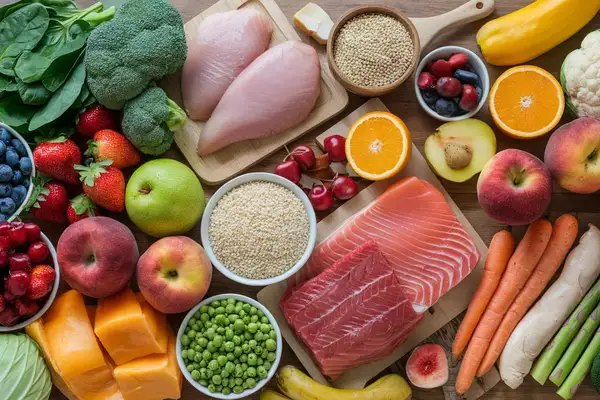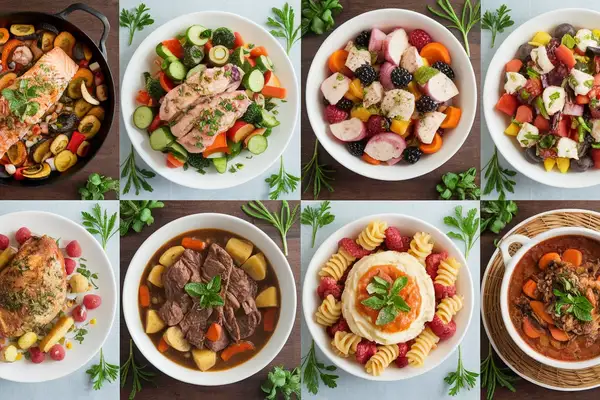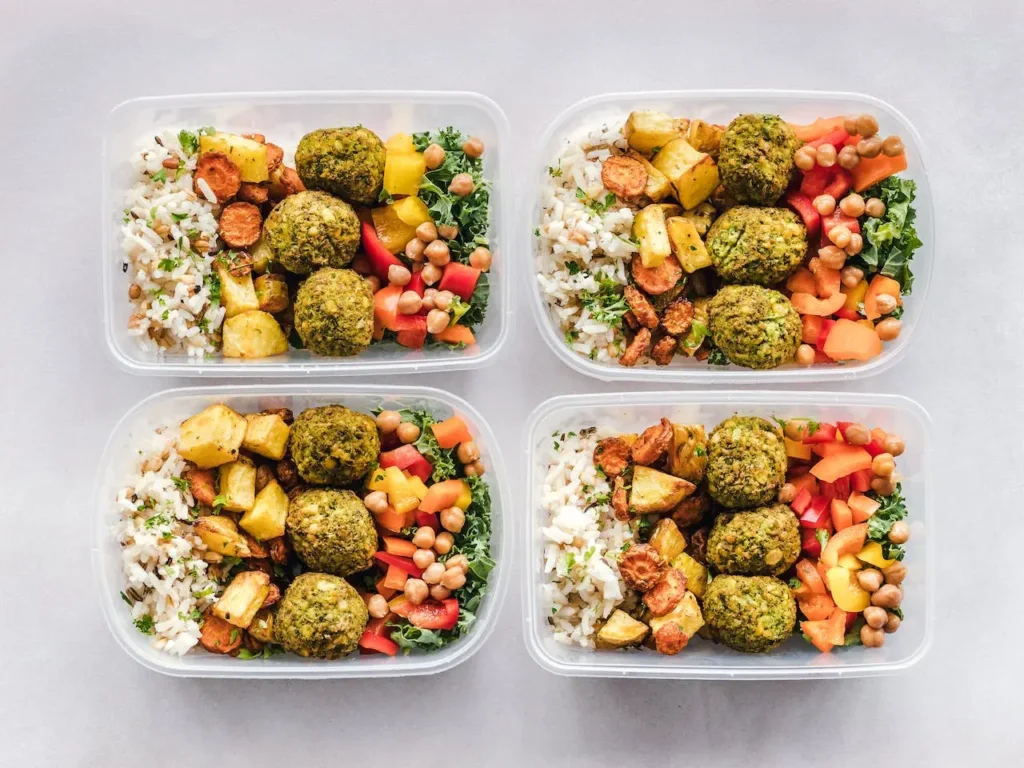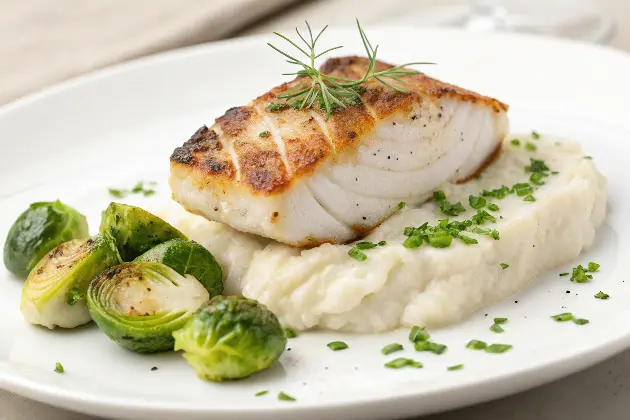Free 7 Day Pescatarian Diet Meal Plan for Beginners
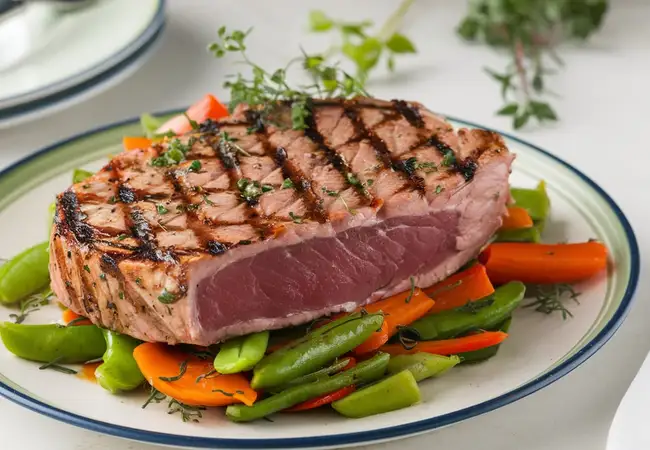
What is a Pescatarian Diet?
This post may contain affiliate links, meaning I may earn a commission if you make a purchase, at no extra cost to you. I only recommend products I trust. Thank you for your support.
A pescatarian diet primarily includes fish and seafood alongside vegetarian foods like fruits, vegetables, grains, legumes, and nuts.
Simply put, it’s a vegetarian diet that includes fish and other seafood. It’s like being a vegetarian with a splash of the sea!
Unlike vegetarians, pescatarians incorporate seafood into their meals, making it a versatile option for those who want to boost protein intake without consuming red or white meat.
This way of eating combines the benefits of a plant-based diet with the nutritional perks of fish, giving you the best of both worlds.
This 7 day pescatarian meal plan or pesco diet is suitable for beginners and rich in omega-3 fatty acids, vitamins, plant-based proteins, and minerals while promoting heart health and weight management.
Pescatarian Food List: Stocking Your Kitchen
To make your pescatarian meal prep easier, here’s a handy list of pescatarian foods to keep in your kitchen:
Fish and Seafood:
- Salmon
- Tuna (fresh and canned)
- Cod
- Halibut
- Trout
- Shrimp
- Scallops
- Mussels
- Crab
- Lobster
Plant-Based Proteins:
- Tofu
- Tempeh
- Legumes (beans, lentils, chickpeas)
- Nuts and seeds
Fruits and Vegetables:
- Leafy greens (spinach, kale, arugula)
- Berries
- Citrus fruits
- Avocados
- Bell peppers
- Broccoli
- Cauliflower
- Carrots
- Tomatoes
- Cucumbers
Grains:
- Quinoa
- Rice
- Whole grain bread and pasta
- Oats
Dairy and Eggs:
- Greek yogurt
- Cheese
- Milk (or plant-based alternatives)
- Eggs
Healthy Fats:
- Olive oil
- Coconut oil
- Avocado oil
Foods to Avoid on a Pescatarian Diet:
- Red Meat and Poultry: Beef, pork, chicken, turkey.
- Processed Foods: Chips, sugary snacks, fast food.
- Trans Fats: Hydrogenated oils, margarine.
- Excessive Mercury Fish: Swordfish, king mackerel, tilefish.
7 Day Pescatarian Meal Plan For Beginners
This 7 day pescatarian diet meal plan features a balanced and flavorful combination of seafood, fresh vegetables, whole grains, and plant-based proteins.
It is designed to provide a variety of nutrients, including omega-3 fatty acids, vitamins, and minerals, while promoting heart health, weight management, and overall wellness.
Here’s a week’s worth of mouth-watering pescatarian meals to get you started. Remember, this is just a guide – feel free to mix and match based on your preferences and what’s available.
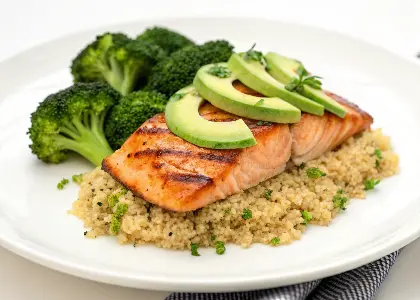
Day 1
Breakfast:
- Smoked Salmon Avocado Toast: Top whole-grain toast with avocado and smoked salmon. (2 slices toast, 1/2 avocado, 3 oz smoked salmon)
Lunch:
- Tuna Salad: Combine canned tuna with Greek yogurt, celery, and spices. Serve over mixed greens. (4 oz tuna, 2 tbsp Greek yogurt, 1/4 cup diced celery, 2 cups mixed greens)
Dinner:
- Grilled Salmon with Quinoa: Grill salmon and serve with cooked quinoa, steamed broccoli, and avocado. (6 oz salmon, 1/2 cup quinoa, 1 cup broccoli, 1/2 avocado)
Snack:
- Hummus with Veggies: Serve hummus with sliced cucumbers and carrots. (1/4 cup hummus, 1/2 cucumber, 1 carrot)
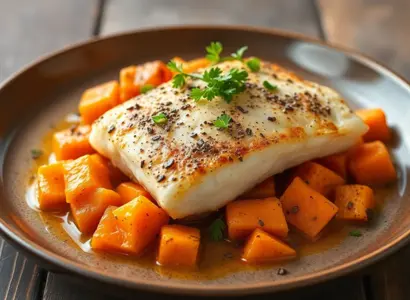
Day 2
Breakfast:
- Greek Yogurt with Berries: Mix Greek yogurt with fresh blueberries and a drizzle of honey. (1 cup Greek yogurt, 1/2 cup blueberries, 1 tsp honey)
Lunch:
- Shrimp Stir-Fry: Stir-fry shrimp with bell peppers, broccoli, and teriyaki sauce. Serve over brown rice. (6 oz shrimp, 1 cup veggies, 1/2 cup rice)
Dinner:
- Baked Cod with Sweet Potato: Bake cod with lemon and herbs. Serve with a baked sweet potato. (6 oz cod, 1 medium sweet potato, lemon slices)
Snack:
- Trail Mix: Mix almonds, dried cranberries, and sunflower seeds. (1/4 cup mix)
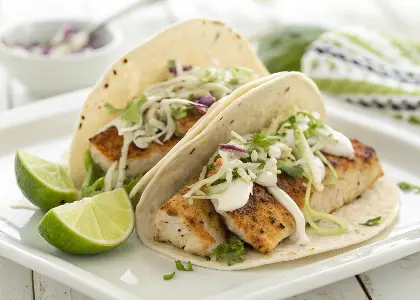
Day 3
Breakfast:
- Veggie Omelette: Make an omelette with spinach, tomatoes, and feta cheese. (2 eggs, 1/4 cup spinach, 1/4 cup tomatoes, 2 tbsp feta)
Lunch:
- Grilled Mahi-Mahi Tacos: Serve grilled mahi-mahi in corn tortillas with shredded cabbage and lime crema. (6 oz mahi-mahi, 2 tortillas, 1/2 cup cabbage, 1 tbsp lime crema)
Dinner:
- Pesto Shrimp Pasta: Toss whole-grain pasta with pesto and shrimp. Add cherry tomatoes. (2 oz pasta, 6 oz shrimp, 2 tbsp pesto, 1/2 cup tomatoes)
Snack:
- Apple with Almond Butter: Slice an apple and serve with almond butter. (1 apple, 2 tbsp almond butter)
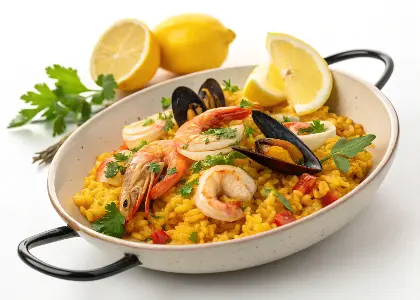
Day 4
Breakfast:
- Smoothie Bowl: Blend frozen berries, banana, and almond milk. Top with granola. (1 cup berries, 1/2 banana, 1/2 cup almond milk, 2 tbsp granola)
Lunch:
- Grilled Tuna Steak: Season and grill tuna. Serve with arugula salad. (6 oz tuna steak, 2 cups arugula, 1 tbsp vinaigrette)
Dinner:
- Seafood Paella: Combine shrimp, scallops, and mussels with saffron rice. (6 oz seafood mix, 1 cup saffron rice)
Snack:
- Cucumber and Cream Cheese: Spread cream cheese on cucumber slices. (1/2 cucumber, 2 tbsp cream cheese)
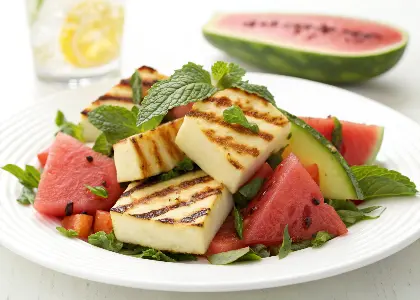
Day 5
Breakfast:
- Avocado and Egg Toast: Top whole-grain toast with mashed avocado and a poached egg. (2 slices toast, 1/2 avocado, 1 egg)
Lunch:
- Grilled Halloumi and Watermelon Salad: Grill halloumi and combine with watermelon cubes and arugula. Drizzle with balsamic glaze. (4 oz halloumi, 1 cup watermelon, ½ cup arugula, 1 tbsp balsamic glaze)
Dinner:
- Baked Halibut with Lentils: Bake halibut and serve with seasoned lentils and steamed green beans. (6 oz halibut, 1/2 cup lentils, 1 cup green beans)
Snack:
- Edamame with Sea Salt: Boil edamame and sprinkle with sea salt. (1 cup edamame, pinch of sea salt)
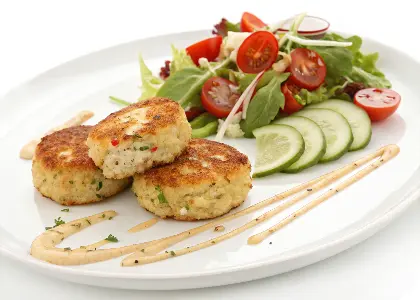
Day 6
Breakfast:
- Berry Parfait: Layer Greek yogurt, granola, and mixed berries. (1 cup yogurt, 2 tbsp granola, 1/2 cup berries)
Lunch:
- Crab Cakes with Salad: Serve crab cakes over arugula with lemon vinaigrette. (2 crab cakes, 2 cups arugula, 1 tbsp vinaigrette)
Dinner:
- Grilled Trout with Wild Rice: Grill trout and serve with wild rice and sautéed spinach. (6 oz trout, 1/2 cup wild rice, 1 cup spinach)
Snack:
- Rice Cakes with Nut Butter: Spread almond butter on rice cakes. (2 rice cakes, 2 tbsp almond butter)
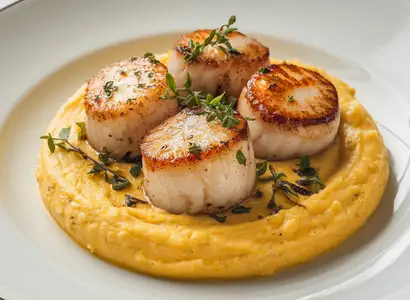
Day 7
Breakfast:
- Spinach and Feta Scramble: Scramble eggs with spinach and feta. (2 eggs, 1/4 cup spinach, 2 tbsp feta)
Lunch:
- Shrimp Caesar Salad: Toss shrimp with romaine, croutons, and Caesar dressing. (6 oz shrimp, 2 cups romaine, 2 tbsp dressing)
Dinner:
- Seared Scallops with Polenta: Sear scallops and serve over creamy polenta with sautéed zucchini. (6 oz scallops, 1/2 cup polenta, 1 cup zucchini)
Snack:
- Dark Chocolate and Walnuts: Enjoy dark chocolate pieces with walnuts. (1 oz chocolate, 1/4 cup walnuts)
Pescatarian Meal Prep: Tips and Tricks
Meal prepping can be a game-changer when you’re starting a new diet. Here are some tips to make your pescatarian meal prep a breeze:
- Batch cook grains: Cook a big batch of quinoa or brown rice at the beginning of the week. These can be used as bases for various meals.
- Prep your veggies: Wash, chop, and store your vegetables in airtight containers. This makes it easy to throw together quick salads or stir-fries.
- Make versatile sauces: Prepare sauces like pesto, tahini dressing, or lemon garlic sauce. These can be used to flavor different dishes throughout the week.
- Cook fish in batches: Grill or bake a few different types of fish to use in various meals. Just be sure to consume within 2-3 days for optimal freshness.
- Prepare grab-and-go snacks: Make energy balls, cut up fruit, or portion out nuts for easy, healthy snacks.
Pescatarian Recipes: Beyond the Meal Plan
While our pescatarian meal plan above is a great start, the world of pescatarian cooking is vast and exciting!
Here are a few more delicious pescatarian recipes to try:
- Spicy Tuna Poke Bowl: A Hawaiian-inspired dish with raw tuna, rice, avocado, and a spicy mayo sauce.
- Lemon Garlic Butter Salmon: A simple yet flavorful way to prepare salmon, perfect for busy weeknights.
- Vegetarian Sushi Rolls: Get creative with cucumber, avocado, and cream cheese rolls.
- Grilled Portobello Mushroom Steaks: A meaty vegetarian option that’s great for barbecues.
- Fish Tacos with Mango Salsa: A fresh and tropical twist on taco night.
- Shakshuka with Feta: A Middle Eastern dish of eggs poached in a flavorful tomato sauce.
- Crispy Baked Fish and Chips: A healthier version of the classic British dish.
Pescatarian Diet Pros and Cons
Like any diet, the pescatarian diet has its advantages and potential drawbacks. Let’s break them down:
Pros:
- Rich in Omega-3s: Fish is an excellent source of omega-3 fatty acids, which are great for heart and brain health.
- High in Protein: Fish and seafood provide high-quality protein without the saturated fat found in red meat.
- Supports Weight Management: The pescatarian diet is often lower in calories while being nutrient-dense, aiding in maintaining a healthy weight.
- Flexible: It’s more flexible than a strict vegetarian diet, offering a wide range of options, from seafood to plant-based meals, making it more diverse and less restrictive than vegetarian or vegan diets.
- Nutrient-Dense: This diet is typically rich in vitamins, minerals, fiber, and antioxidants from fruits, vegetables, and fish.
Cons:
- Mercury Concerns: Certain fish like swordfish and king mackerel may contain high levels of methyl mercury, posing a brain risk if consumed frequently and in large quantities.
- Cost: Fresh fish and seafood can be more expensive than other protein sources.
- Potential for Nutrient Deficiencies: Without proper planning, pescatarians might miss out on certain nutrients found in meat, like vitamin B12, iron, and zinc.
- Food Safety: There’s a higher risk of foodborne illness with raw or undercooked fish.
Conclusion
There you have it, folks! A comprehensive guide to kickstart your pescatarian diet.
Remember, transitioning to a new way of eating is a process, so be patient with yourself. Feel free to adjust the pescatarian meal plan to suit your tastes and lifestyle.
The pescatarian diet for beginners offers a beautiful balance of plant-based goodness and the nutritional benefits of fish. It’s a flexible, sustainable, and delicious eating method that can support your health and the planet.
So, are you ready to dive into the pescatarian lifestyle? With this pescatarian diet plan guide, you’re all set to make a splash in your culinary adventures.
- Diet to lower cortisol
- Mediterranean diet meal plan
- Daniel fast meal plan
- Cabbage soup diet for weight loss
- One Meal a Day (OMAD) meal plan
- Low oxalate fruits
- No sugar meals
- 7 day meal plan for insulin resistance
FAQs
Can I eat eggs if I’m pescatarian?
Yes, most pescatarians do eat eggs. Eggs are a great source of protein and other nutrients, making them a valuable addition to a pescatarian diet.
Can pescatarians eat tofu?
Absolutely! Tofu is a fantastic plant-based protein source that fits perfectly into a pescatarian diet. It’s versatile and can be used in many dishes.
Will I lose weight if I go pescatarian?
A pescatarian diet can lead to weight loss, it is lower in calories and saturated fat than diets that include red meat, which can contribute to weight loss.
Can pescatarians eat pizza?
Yes, pescatarians can eat pizza! Just opt for vegetarian toppings or add some seafood like anchovies or shrimp. You can also try making your own pizza with a whole grain crust and lots of veggies.
What is the best source of protein for Pescatarians?
Fish and seafood are excellent protein sources for pescatarians. However, eggs, dairy, legumes, and plant-based proteins like tofu and tempeh are also great options to ensure a well-rounded diet.
Can a pescatarian eat chicken?
No, pescatarians do not eat chicken or any other poultry. The pescatarian diet includes fish and seafood but excludes all other meats.
